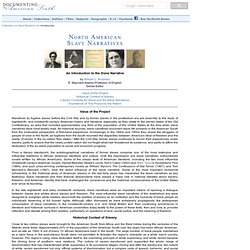

Slave Narratives: An Introduction to the Slave Narrative. An Introduction to the Slave Narrative Value of the Project Narratives by fugitive slaves before the Civil War and by former slaves in the postbellum era are essential to the study of eighteenth- and nineteenth-century American history and literature, especially as they relate to the eleven states of the Old Confederacy, an area that included approximately one third of the population of the United States at the time when slave narratives were most widely read.

As historical sources, slave narratives document slave life primarily in the American South from the invaluable perspective of first-hand experience. Increasingly in the 1840s and 1850s they reveal the struggles of people of color in the North, as fugitives from the South recorded the disparities between America's ideal of freedom and the reality of racism in the so-called "free states. " Historical Context of Slavery. Mary Boykin Miller Chesnut, 1823-1886 A Diary from Dixie, as Written by Mary Boykin Chesnut, Wife of James Chesnut, Jr., United States Senator from South Carolina, 1859-1861, and Afterward an Aide to Jefferson Davis and a Brigadier-General in the Confeder.
The Civil War Home Page. The American Civil War Homepage. Civil War Literature - Home.